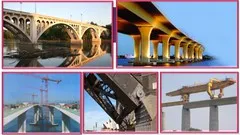
Earthquake Resistant Design of Foundations 
This course provides an overview of earthquake resistant design of foundations. It covers topics such as types of shallow and deep foundations, IS codes for bearing capacity and settlement, methods of analysis, dynamic bearing capacity, pile foundations, well foundations and caissons, and soil-structure interaction. Students will gain knowledge on how to design foundations to withstand earthquake loads and understand the limitations of various codes. ▼
ADVERTISEMENT
Course Feature
![]() Cost:
Cost:
Free
![]() Provider:
Provider:
Swayam
![]() Certificate:
Certificate:
No Information
![]() Language:
Language:
English
![]() Start Date:
Start Date:
Self Paced
Course Overview
❗The content presented here is sourced directly from Swayam platform. For comprehensive course details, including enrollment information, simply click on the 'Go to class' link on our website.
Updated in [May 25th, 2023]
This course on Earthquake Resistant Design of Foundations provides learners with a comprehensive overview of the various types of foundations and their performance during past earthquakes. Learners will gain an understanding of the IS codes for bearing capacity and settlement of foundations, foundation design, modes of soil failure, safe bearing capacity, differential and total settlements, increase in permissible stress under earthquake loads, methods of analysis, experimental investigations, combined footings for earthquake loads, raft foundation, modulus of sub grade reaction, Winkler model, beam on elastic foundation, dynamic bearing capacity under transient and earthquake type loads, types of piles based on usage, material, construction, pile load capacity in compression, bearing capacity of piles, group action of piles, settlement of a pile group, laterally loaded piles, elastic analysis, Reese and Matlock approach, fixity of pile heads, dimensionless factors, pile with dynamic loads, soil-pile analysis with spring-mass and FEM idealisation, elements for slip and separation, soil-pile interaction, IS code of practice for design of pile foundations, piles through liquefiable soils, types of well foundations and caissons, scour depth, depth and bearing capacity of wells, static forces considered in stability of wells, lateral stability of well foundations, pseudo-static analysis with earthquake induced loads, lateral load resistance of well foundation, Terzahi's approach, IRC, IS and Indian Railway Codes, their limitations, soil-structure interaction, modelling of unbounded soil media for dynamic loads, free field motion, kinematic interaction and inertial interaction. Learners will also gain an understanding of the design principles and techniques for designing earthquake resistant foundations.
[Applications]
The application of this course can be seen in the design of foundations for structures that are located in areas prone to earthquakes. The course provides a comprehensive understanding of the various types of foundations and their performance during past earthquakes. It also provides guidance on the design of shallow foundations, pile foundations, well foundations and caissons, and the soil-structure interaction for deep foundations. The course also covers the relevant codes of practice for the design of foundations, such as the IS codes, IRC codes and Indian Railway codes. This knowledge can be used to design foundations that are resistant to earthquake loads and ensure the safety of structures.
[Career Paths]
1. Earthquake Engineering Consultant: Earthquake engineering consultants are responsible for designing and constructing buildings and other structures to withstand the effects of earthquakes. They must be knowledgeable in the latest seismic codes and regulations, and be able to develop innovative solutions to meet the needs of their clients. As the demand for earthquake-resistant structures increases, the need for experienced earthquake engineering consultants is expected to grow.
2. Structural Engineer: Structural engineers are responsible for designing and constructing buildings and other structures to withstand the effects of earthquakes. They must be knowledgeable in the latest seismic codes and regulations, and be able to develop innovative solutions to meet the needs of their clients. As the demand for earthquake-resistant structures increases, the need for experienced structural engineers is expected to grow.
3. Geotechnical Engineer: Geotechnical engineers are responsible for designing and constructing foundations and other structures to withstand the effects of earthquakes. They must be knowledgeable in the latest seismic codes and regulations, and be able to develop innovative solutions to meet the needs of their clients. As the demand for earthquake-resistant structures increases, the need for experienced geotechnical engineers is expected to grow.
4. Earthquake Researcher: Earthquake researchers are responsible for studying the effects of earthquakes on the built environment. They must be knowledgeable in the latest seismic codes and regulations, and be able to develop innovative solutions to better understand the effects of earthquakes. As the demand for earthquake-resistant structures increases, the need for experienced earthquake researchers is expected to grow.
[Education Paths]
1. Bachelor of Science in Civil Engineering: This degree program focuses on the design, construction, and maintenance of physical structures such as bridges, roads, and buildings. It also covers topics such as earthquake-resistant design, soil mechanics, and structural analysis. This degree is becoming increasingly important as the need for more resilient infrastructure grows.
2. Master of Science in Earthquake Engineering: This degree program focuses on the study of seismic waves and their effects on structures. It covers topics such as seismic hazard assessment, seismic design, and seismic retrofitting. This degree is becoming increasingly important as the need for more resilient infrastructure grows.
3. Doctor of Philosophy in Structural Engineering: This degree program focuses on the design, analysis, and testing of structures. It covers topics such as structural dynamics, finite element analysis, and structural optimization. This degree is becoming increasingly important as the need for more resilient infrastructure grows.
4. Master of Science in Structural Engineering: This degree program focuses on the design, analysis, and testing of structures. It covers topics such as structural dynamics, finite element analysis, and structural optimization. This degree is becoming increasingly important as the need for more resilient infrastructure grows.
Course Provider

Provider Swayam's Stats at AZClass
Discussion and Reviews
0.0 (Based on 0 reviews)
Explore Similar Online Courses

Android Auto Development

Intro to Procreate: Illustrating on the iPad (UPDATED for 2022)

Python for Informatics: Exploring Information

Social Network Analysis

Introduction to Systematic Review and Meta-Analysis

The Analytics Edge

DCO042 - Python For Informatics

Causal Diagrams: Draw Your Assumptions Before Your Conclusions

Whole genome sequencing of bacterial genomes - tools and applications

Basics of Civil Engineering Mechanics - Beginner Course

Roof Runoff Structure Design (NRCS Standard 558)

Site Engineer
 Related Categories
Related Categories
 Popular Providers
Popular Providers
Quiz
 Submitted Sucessfully
Submitted Sucessfully
1. What is the main purpose of this course?
2. What type of loads are considered in the stability of wells?
3. What type of analysis is used for pile foundations with dynamic loads?
4. What is the purpose of the course 'Earthquake Resistant Design of Foundations'?
Correct Answer: To learn about the design of foundations to resist earthquakes.


Start your review of Earthquake Resistant Design of Foundations